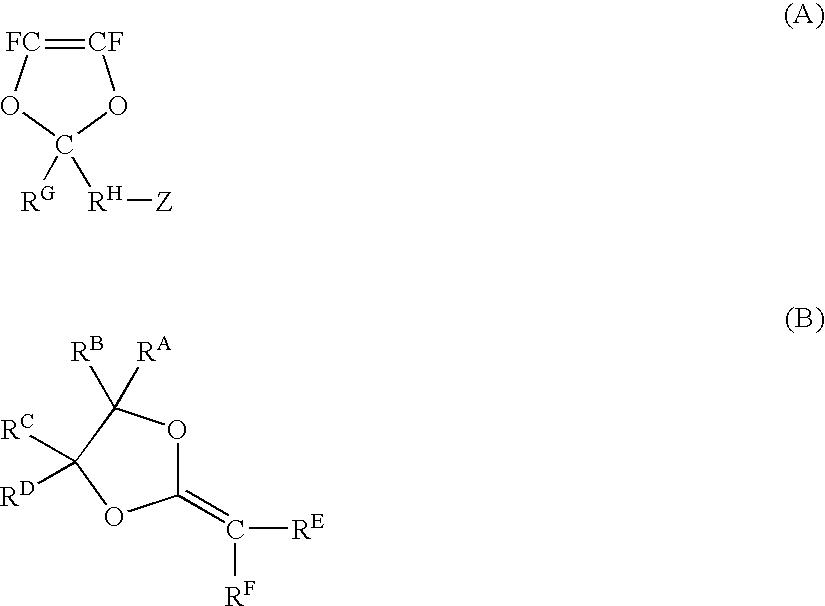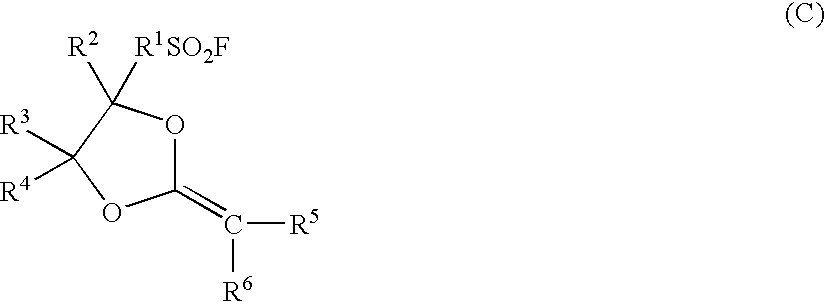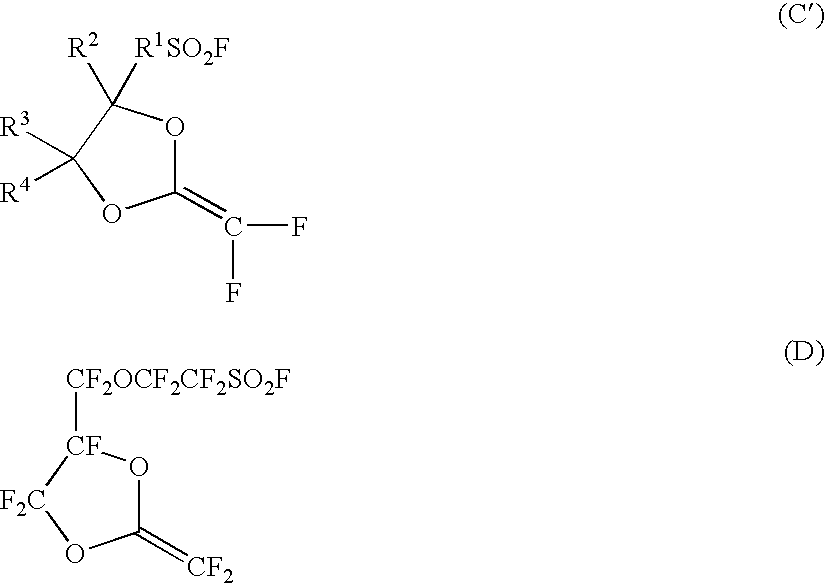Electrolyte material, electrolyte membrane and membrane-electrolyte assembly for polymer electrolyte fuel cells
a fuel cell and electrolyte technology, applied in the field of electrolyte membrane and membrane-electrolyte assembly of polymer electrolyte fuel cells, can solve the problems of low output of fuel cells, poisoning of electrolyte catalysts, and low softening temperature, and achieve excellent chemical durability, high softening temperature, and excellent durability
- Summary
- Abstract
- Description
- Claims
- Application Information
AI Technical Summary
Benefits of technology
Problems solved by technology
Method used
Image
Examples
example 1
[0081] A FEP form (tradename: Toyoflon 50F, manufactured by Toray Industries, Inc., thickness: 50 μm) substrate was irradiated with γ rays of 20 kGy in a nitrogen atmosphere and then the substrate was immersed in compound (D) and reacted at 60° C. for 117 hours. After the reaction, the substrate was withdrawn, washed with HCFC225cb and dried, and weighed. The degree of grafting was calculated by the following calculating formula and as a result, the degree of grafting was 43% and AR was 0.8.
[0082] Degree of grafting=(mass of the substrate after reaction−mass of the substrate before reaction) / mass of substrate before reaction
[0083] Then, the obtained membrane-shape graft copolymer was immersed in a 18% (mass ratio) potassium hydroxide aqueous solution and heated at 80° C. for 16 hours to convert —SO2F groups to —SO3K groups. Then, the graft copolymer was washed with water and immersed in 2 mol / L hydrochloric acid to convert the —SO3K groups to sulfonic acid groups, and washed with...
example 2
[0084] A membrane sample having sulfonic acid groups made of a graft copolymer was obtained in the same manner as in Example 1 except that the amount of irradiation of γ rays was 50 kGy. The degree of grafting was 87%, and AR was 1.1.
example 3
[0085] A membrane having —SO2F groups (degree of grafting of 85%, AR of 1.1 when hydrolyzed and converted to an acid form) obtained in the middle of the procedure in Example 2, was subjected to fluorination treatment by the following method and further hydrolyzed and converted to an acid form.
[0086] A multistage shelf made of a hastelloy C alloy was put in a pressure resistant reactor having an internal capacity of 32 L and having an internal surface made of a hastelloy C alloy, and 0.25 MPa by the gauge pressure of is a gas mixture of 20% of a fluorine gas and 80% of a nitrogen gas was introduced and maintained at 190° C. for 4 hours to make the metal surface be a non-conductor. After the temperature was lowered, the above membrane sample was put on the shelf in the 32 L pressure resistant reactor, and 0.25 MPa by the gauge pressure of a gas mixture of 20% of a fluorine gas and 80% of a nitrogen gas was introduced and maintained at 180° C. for 4 hours to carry out fluorination tre...
PUM
| Property | Measurement | Unit |
|---|---|---|
| softening temperature | aaaaa | aaaaa |
| temperature | aaaaa | aaaaa |
| temperature | aaaaa | aaaaa |
Abstract
Description
Claims
Application Information
 Login to View More
Login to View More - R&D
- Intellectual Property
- Life Sciences
- Materials
- Tech Scout
- Unparalleled Data Quality
- Higher Quality Content
- 60% Fewer Hallucinations
Browse by: Latest US Patents, China's latest patents, Technical Efficacy Thesaurus, Application Domain, Technology Topic, Popular Technical Reports.
© 2025 PatSnap. All rights reserved.Legal|Privacy policy|Modern Slavery Act Transparency Statement|Sitemap|About US| Contact US: help@patsnap.com



